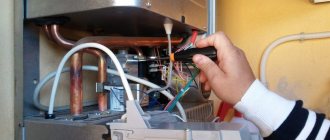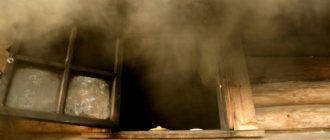Gas units are not intended for location in enclosed spaces. It is almost impossible to obtain official approval for installation. Why do gas workers refuse, what motivates the ban, what documents are they referring to and what to do in this case? Find out the answers to these questions from this article.
- 2 Regulatory standards
- 3 SNiP regulations, comments on standards
3.1 What requirements must a bathroom meet?
Is it possible to install a gas boiler in a bathroom?
In Soviet times, this arrangement of speakers was practiced in five-story buildings. Technical standards in the USSR allowed this. This arrangement made sense - while bathing, a person could regulate the heating temperature of the water. In addition, bulky equipment did not spoil the interior of the kitchen.
Modern standards prohibit installing or hanging boilers in bathrooms. The main reason is the large number of cases of carbon monoxide poisoning. There is no direct ban, but standards for compliance of premises have been stated. The bathroom and toilet do not meet these requirements. Therefore, if it is possible to place the device in another room, give up the idea of unauthorized mounting of the device.
Show or hide
Of course, we all want to make the bathroom the most comfortable and aesthetically pleasing room possible, because this is a territory not only of hygiene, but also of relaxation. Large-sized gas equipment that is not always attractive in appearance usually does not fit into our ideas of a beautiful and comfortable bathroom, although now you can find speakers on sale that can become a decoration for the bathroom.
It would seem that the most obvious solution is to hide the gas water heater inside the wall, but all standards and safety requirements strictly prohibit this. Therefore, if you do not want to leave your instantaneous water heater in plain sight, you can hide it in a plasterboard niche or in a closet.
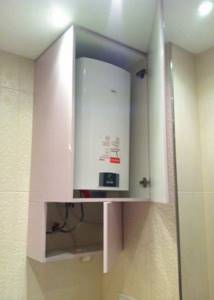
This is interesting: Which bathtub is better, acrylic or cast iron?
Regulatory Standards
The story of obtaining documentary consent to install a gas boiler in a bathroom is complicated by confusion with permitting papers. Current regulations do not contain specific information about whether it is feasible to place the device in a bathroom.
Gas company employees refuse, citing SNiP 2-04 . The ban is clearly regulated there.
However, according to the Decree of the State Construction Committee, these documents have lost their legal force. The result is that difficulties and misunderstandings arise. To get approval from gas workers, you need to collect a bunch of papers. Unauthorized connection is fraught with big problems.
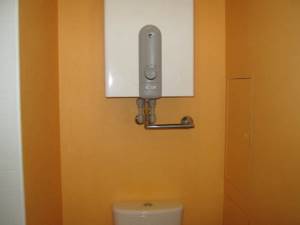
Use of liquefied gas
“Problems” with project documentation are not required in the case of using not natural, but liquefied “ballooned” gas. However, in this case the column must have an appropriate design - burners for natural and liquefied gas have different diameters of injector nozzles. Although such equipment is produced by many manufacturers, it is quite rare on sale and is demanding in terms of gas quality.
In any case, the wall where the speaker is installed must be strong and non-flammable - if it is made of plasterboard, then a “mortgage” for attaching the heater, made of wood or metal, must be mounted in it in advance.
SNiP regulations, comments on standards
The procedure for installing equipment in residential spaces is regulated by SNiP. The document says: it is not recommended to hang a gas boiler in bathrooms and toilets - provision 2-04 SNiP.
The paradox is that this standard is being canceled by another document - Gosstroy Resolution No. 163. Together with it, the Gas Distribution Code SP 62-13330 came into force. There is no information about the ban at all. The document defines the general conditions that apply to the premises where the equipment is planned to be installed. Let us consider them in more detail in relation to a specific space.
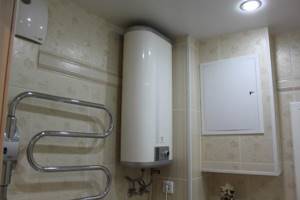
What requirements must a bathroom meet?
Standard placement principles:
- useful area - less than 7 m, total - from 9 - for gas equipment with an open burner. For closed models - from 8 squares;
- there is a supply and exhaust;
- window - its parameters depend on the energy consumed by the equipment. If we are talking about an apartment building, the standard requirement is an opening of no more than 1.7 square meters;
- Leave a space of 2-3 centimeters between the door and the frame. Experts recommend installing a ventilation grill into this space at the bottom of the door;
- the distance from the wall opposite is 1 meter - this is necessary for uniform circulation of air flow.
From the listed nuances it is clear that locating the boiler in the toilet is impossible precisely because of the inadequacy of the room - a small square area, no natural light.
Selecting a gas device
A geyser is a device that is not purchased for a day or a month. Such a mechanism should serve you for years without causing any complaints.
To make your choice the most practical and effective, when choosing a geyser, pay attention to the following parameters:
Gas water heater performance
This most important criterion is responsible for the volume of water that the device can heat in one unit of time. As we mentioned, speakers are divided into low, medium and high power products.
Your choice depends on the following nuances:
- your personal needs;
- number of people living in the house;
- number of intake points: the mechanism can heat water not only for the bathroom, but also for the kitchen.
A gas boiler can heat water for the kitchen and bathroom
If each aspect is higher, you need to give preference to a more powerful product.
Ignition type
The column can be ignited by matches (a lighter), a piezo that provides a spark, or automatic equipment.
Such a mechanism is both safer and more convenient.
Burner type
This nuance is very important, because some models require your intervention, which is not very practical. For example, a constant power burner requires manual adjustment. And the modulating power burner independently adjusts to frequently changing water pressure, guaranteeing a stable temperature level.
Removal of combustion products
At this point, you need to choose a turbocharged or chimney engine. In the first case, all waste is removed through the pipe simply into the street, in the second case - into the chimney.
There are two options for waste disposal: turbocharged or chimney method
Safety
Each device has several levels of security. Experts recommend purchasing a product with three degrees of protection for the bathroom. Such mechanisms have the following protective functions:
ionization sensor: self-blocking; if the flame goes out, the draft level will decrease or disappear altogether; overheating sensor: pay attention to the presence of a hydraulic safety valve that will protect the mechanism from overheating; combustion sensor: the system will automatically shut off the gas supply if the flame goes out and the ionization sensor does not work; draft sensor: protects the column from turning on or off in the absence of draft; water temperature sensors.
Each of the sensors is optional, but you must admit that with them you will be much calmer.
We have presented to you the most important five criteria that will determine the quality and durability of a new bathroom device. However, do not forget about the manufacturer, which is also important when choosing a speaker.
Valliant geyser
Among the world's manufacturers of such equipment, the following names enjoy the greatest confidence:
- Ariston;
- Termaxi;
- Vaillant;
- Beretta.
Gas water heaters produced by the presented manufacturers are considered the golden mean in the equipment market. Such companies offer a wide selection of devices at different prices, and most importantly, of high quality.
What is the penalty for installing a gas boiler in a bathroom?
The reasons why it is prohibited to install gas equipment seem unfounded to many. But the punishment for unauthorized installation is quite serious. Self-installation means, at a minimum, penalties and forced removal.
Unscrupulous users circumvent the law. They order design papers in such a way that the premises are listed as a boiler room. The bathroom, accordingly, is excluded from the project plan. The gas unit is installed and connected. After this, all plumbing returns to its place. The apartment owner happily forgets about troubles and problems with documents.
A year later, when gas workers check the operation of the boiler, violations will come to light. The employee will draw up a report and issue a fine, the minimum amount of which is 45,000 rubles.
Legal information! If the illegal installation of gas equipment caused damage to someone else’s property or resulted in the loss of human health or life, criminal liability and a real sentence of 2 to 5 years arise.
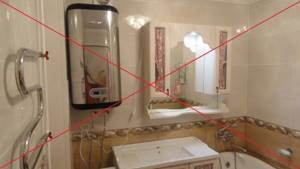
Advice! If you still decide to install a boiler in the toilet, do it legally. Since regulatory documents do not strictly prohibit installation, proceed as follows:
- submit an application to the head of the gas organization with a request to install a boiler in the bathroom or toilet;
- motivate your demand, formulate the reasons why you insist on installation in this location;
- attach supporting documents;
- If the arguments were not enough, write a statement of claim to the court. There is a chance that the decision will be made in favor of the plaintiff.
Answers from experts
Generous:
it is possible but is it necessary? another place can be found
Yuri Morozenkov:
Would you like to wash between the pipes?
Ivan Kuleshov:
Theoretically, it is possible, this particular Ariston has an IP X4D protection class, you can hang it in the bathroom. Another question is whether the area of the room allows this to be done.
Maria:
You will not meet the requirements for the dimensions of the room and the presence of fresh ventilation - windows with a window. Or more precisely, ask your gas workers; anyway, you will draw up the project and have it certified by them.
Vladimir Petrov:
Here I am reading the passport for a boiler with a closed combustion chamber. They can be located in the bathroom in zone 3 at a distance of min. 60cm from the edge of the bathtub or shower. And you need to ground current-carrying parts in accordance with CSN 33 2000-4. So you can bet. If only the bathroom wall faced the street, the exhaust would flow.
Truculentus:
6.37.* Installation of water heaters, heating boilers and heating devices should be provided in kitchens and non-residential premises intended for their placement and meeting the requirements of paragraphs. 6.42 * and 6.43 . THE INSTALLATION OF THE SPECIFIED DEVICES IN BATHROOMS IS NOT ALLOWED. The issue of the need to move gas water heaters from bathrooms, in which they were placed in accordance with previously existing standards, to kitchens or other non-residential premises of a residential building during the reconstruction of a house or gas supply system, should be decided on a case-by-case basis by the design organization in agreement with local operating organizations gas industry. In existing residential buildings, it is allowed to provide for the installation of gas heating appliances and heating devices in corridors for individual use that meet the requirements of paragraphs. 6.42 * and 6.43 .
The distance from the protruding parts of gas burners or fittings to the opposite wall must be at least 1 m.
Verik:
I don’t see a problem with this... hang it up, there’s protection there
Spitz Pomeranian:
I agree with Verkisto. The gas service will not allow it.
Henry Hayes:
A friend of mine has an Aristonov wall mount (genus with a boiler) installed in the bathroom. But they have a private house according to the Ind. project built and a bathroom with a total area of 9 square meters. So - if the space allows, then hang the boiler wherever you want.
Vyacheslav:
)))))))))))))) why not ask the organizations that give permission?
AVR TECH:
no, it's better to put it in the kitchen
Cafe bar Ermak:
The gas boiler MUST be placed in a room where there is natural ventilation (window)
Truculentus:
Can be installed in the bathroom if this room meets the requirements for installing a gas boiler. Details about the requirements: SP 42-101-2003 SNiP 42-01-2002
Alexei:
and in the requirements... room area... separate entrance... glazing area... free access for maintenance personnel... inflow cross section...
It’s better to place the bathroom in the same room as the instantaneous boiler. The water will be regulated faster by the tap)))
Tatyana Otmakhova:
I doubt that the VDPO will sign the act. Call the VDPO in your city, they will tell you everything in detail.
Vlad:
Where in the project (BTI documents) it should be there. Otherwise, redevelopment. With mandatory approval from the gas supply organization. 99 percent of the time they won’t give it. What did you write about above?
Which boiler can be installed in a bathroom?
If you decide to install a boiler in a toilet, choose the equipment correctly. The Code of Practice dated January 2003 does not prohibit the installation of gas units in the bathrooms of apartment buildings that are not connected to an individual or central heating system. The main condition is the closed type of the boiler chamber.
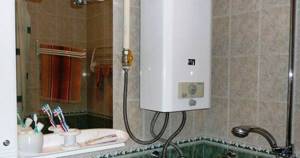
Caution and professionalism are a must
Technically, installing a gas water heater is not the most difficult construction operation. However, in no case should we forget that any actions with gas equipment should be carried out only by professionals and only after obtaining all the necessary permits. Permits are not required only when simply replacing an existing gas heater with another similar device - however, this matter should also be trusted to specialists, since gas rarely forgives installation errors.
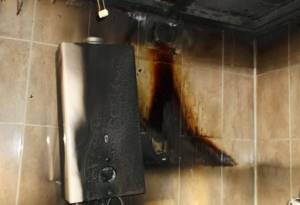
In addition, for safety reasons, it is strongly recommended to install gas leak detectors in rooms with gas equipment and install water heaters equipped with a gas control system.
Official conditions for the location of gas water heaters in the bathroom
Why do many people want to hang a boiler in the bathroom? This location has a number of advantages:
- compactness;
- the device does not spoil the interior of the kitchen, does not take up additional space;
- hot water flows directly to its destination - to the shower and sink.
Installation rules:
- redesign the premises;
- record changes in technical documentation;
- register the boiler with the gas company. To do this, reformat the room in the BTI - give it the status of a storage room;
- Call a specialist - a representative of the gas service and connect the equipment.
Features of kitchen renovation and design with a gas water heater
When planning the design and renovation of a kitchen with a gas heater, you need to take into account fire safety rules, ventilation and ergonomic requirements. Here are some important tips to help you design your workspace in the best possible way.
- If you are equipping a kitchen from scratch, then it is advisable to think about the location of the gas water heater, layout and interior design even before renovating and purchasing furniture. Then you will have more room for maneuver and fewer problems. For example, you can move the speaker, change it to a more modern model or one that suits the future environment, improve the ventilation and chimney at the same time, adjust the color scheme of the interior to match the speaker, etc.
- It is advisable to purchase a kitchen set to order, regardless of whether you plan to build the water heater into a cabinet or not. This will allow you to arrange your headset without errors and use every centimeter to your advantage.
- Is it possible to install a suspended ceiling in a kitchen with a gas water heater? It is possible if the height of the room with the sheet installed is at least 2.25 m, and there remains a distance of at least 8 cm from the chimney opening to the ceiling. In this case, it is advisable to equip the chimney not with an aluminum corrugated pipe, which gets very hot, but with a sandwich chimney with thermal insulation layer. This way, the ceiling will not be damaged by heat (from combustion products going into the chimney) and will not itself become an obstacle to draft. If necessary, the chimney opening can be lowered slightly.
- The walls in a kitchen with a gas water heater should not be decorated with wallpaper or plastic panels (at least near the water heater), as these materials can deteriorate/melt under the influence of heat. Ideally, the walls should simply be plastered, painted or finished with ceramic tiles (see photo).
Small kitchen with geyser and walls lined with ceramic tiles
- In a kitchen with a gas water heater, a constant flow of fresh air is required (50-90 cubic meters per hour). This is necessary both for your safety and for the combustion stability of the unit. Therefore, when installing plastic windows, choose those that have a micro-ventilation function, that is, special fittings that allow you to open windows with micro-slots from 3 to 7 mm. Both in winter and in summer, kitchen windows with a gas water heater should be opened in this mode. If wooden windows are planned or have already been installed in the kitchen, then due to their natural micro-slits the issue of passive ventilation will be resolved by itself. The main thing is not to overdo it with waterproofing, seals and window insulation.
- Supply ventilation valves embedded in the wall, for example, Kiv-125 or KPV-125, will help ensure air flow even more effectively. It is advisable to take care of their installation before repairs, so as not to spoil the finish.
- In a kitchen with a gas water heater, both the supply and exhaust systems must work in a balanced manner. Therefore, it is necessary to invite professional ventilation specialists to check the chimney and ventilation duct. If necessary, they need to be put in order. And, of course, when arranging your kitchen, do not make the most serious and, unfortunately, common mistake - do not cover the ventilation duct with plasterboard boxes, wallpaper, or furniture.
- And the last piece of advice - “in any unclear situation,” consult the gas service and act in accordance with the requirements of regulatory documents.
Types of equipment
There are two types of boilers:
- storage water heater;
- flow boiler.
Storage type equipment is a boiler that is similar to a boiler. The device is equipped with a reservoir of various capacities. Storage elements are placed inside the tank. As hot water is consumed from the tank, the tank is filled with tap water. The automatic control panel allows you to regulate the heating temperature, prevents overheating and boiling of the liquid in the tank. Such boilers are produced in two modifications:
- hanging - they are mounted on the wall;
- stationary - installed on the floor.
A flow-through boiler has a more complex design. The column heats up quickly thanks to the heat exchanger. The liquid will become hot in 7-10 minutes. The main advantages of flow-through boilers:
- efficiency;
- ease of operation;
- reliability of the unit.
In addition, such devices have an automatic ignition system. This guarantees the safety of using the equipment - gas vapors are burned in full.
As practice shows, flow-type boilers are more popular. The device has small parameters, it is convenient to place it in small rooms. At the same time, the boiler’s power is enough for a family of 5 people.
Additional installation conditions
It must be remembered that placing gas appliances in the basements of apartment buildings is prohibited. When installing, you must follow the following rules from clause 7.3.8:
- Gas units and heat generators are mounted on walls made of non-flammable or low-flammable materials .
- The installation must be carried out so that the gaps between the device and the wall are at least 3 cm .
- The finishing of walls near the heat generator must be made of fireproof materials .
- The facing coating must extend beyond the unit body by no less than 10 cm .
- For floor-standing equipment, additional fire safety measures must be taken. The floor surface where the heat generator is installed should be covered with special non-flammable materials . This area must be arranged so that it extends beyond the body of the gas appliance by at least 10 cm.
The official regulatory document on heating, ventilation devices and air conditioning 41 – 01–2003 in the section on heat supply systems provides rules for the installation and operation of gas appliances, as well as technical conditions for rooms where such equipment is connected.
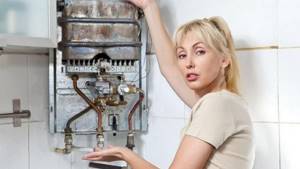
In residential multi-storey buildings and various outbuildings, it is necessary to install heat generators with a sealed combustion chamber and automatic safety devices. Such devices stop the flow of gas when the power suddenly goes out, the protection circuits break down, when the burner malfunctions or when the pressure in the coolant decreases significantly. Sometimes an automatic emergency shutdown is necessary when there is poor smoke removal or other equipment malfunctions.
According to existing standards, units whose power does not exceed thirty-five kilowatts are allowed to be installed in the kitchen or hallway.
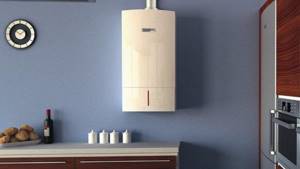
Appliances with heating output exceeding the specified norm must be installed in separate extensions. The total power of such equipment should not exceed one hundred kilowatts according to the standards.
The supply of oxygen for combustion processes must occur through the air duct. It must be placed on the street side for equipment with a sealed chamber. And for open-type heat generators, air is taken from the very room in which the installation was carried out. These requirements are listed in paragraph 6.2.4 of SNiP.
Provision 6.2.5 of this document states that the chimney must be positioned vertically. In this case, it is not allowed to reduce the cross-section of the smoke exhaust pipe. It cannot be laid in residential premises.
In the room where the heat generator with a sealed combustion chamber is located, it is necessary to equip general exchange ventilation, the calculation of which should be at least 1 exchange per hour.
When installing devices with an open combustion chamber, it is necessary to take into account the air flow for fuel combustion. The ventilation design prevents vacuum, which affects the removal of smoke from the heat generator.
Installation principles
When choosing a boiler installation location, follow the basic rules for locating gas equipment:
- the device is installed so that it can be approached from any side and there is free access to the handles or control panel;
- water supply hoses must not be bent;
- if the boiler is wall-mounted, hang it so that a person can use it from the floor - without standing on a stool.
A gas boiler is a piece of equipment that can become potentially dangerous. For this reason, its placement is not recommended in the bathroom and toilet. If you nevertheless decide to install the unit in these rooms, obtain the official consent of the gas service. Follow the installation technology and room requirements.
Some nuances of installing flow-through gas heaters in the toilet and bathroom
For owners of private cottages, there is another way to obtain official permission to install a boiler or gas heater in the bathroom. First, official documentation is drawn up when developing the project.
Install gas equipment in the part of the home where it is permitted. Then plumbing fixtures, such as a bathtub, are installed next to the fixture and a plasterboard partition is built around it. Such an improvised redevelopment, of course, cannot be called ideal. Subsequently, if the owner wants to sell the house, a number of problems may arise. Specialists from the Bureau of Technical Inventory will be able to conduct an examination only after dismantling the walls.
Officially, installation of a gas boiler is provided only for technical premises - storage rooms, change houses. If such rooms meet the requirements adopted for them, the installation of gas-fired water heaters is permitted.
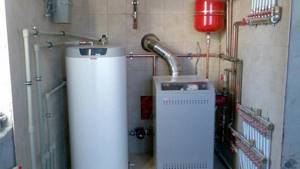
High levels of humidity in the bathroom and temperature fluctuations often lead to breakdowns of gas heating appliances. Before deciding to install it, it is worth considering all the advantages and disadvantages and assessing the financial feasibility of installing such equipment. Obtaining official permission from the relevant authorities is not easy; this can be done by applying some legal tricks.







